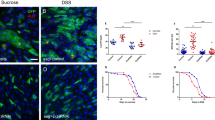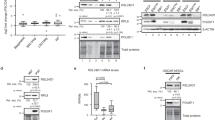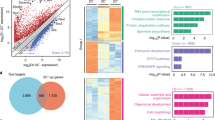Abstract
When embryonic stem cells (ESCs) differentiate, they must both silence the ESC self-renewal program and activate new tissue-specific programs. In the absence of DGCR8 (Dgcr8-/-), a protein required for microRNA (miRNA) biogenesis, mouse ESCs are unable to silence self-renewal. Here we show that the introduction of let-7 miRNAs—a family of miRNAs highly expressed in somatic cells—can suppress self-renewal in Dgcr8-/- but not wild-type ESCs. Introduction of ESC cell cycle regulating (ESCC) miRNAs into the Dgcr8-/- ESCs blocks the capacity of let-7 to suppress self-renewal. Profiling and bioinformatic analyses show that let-7 inhibits whereas ESCC miRNAs indirectly activate numerous self-renewal genes. Furthermore, inhibition of the let-7 family promotes de-differentiation of somatic cells to induced pluripotent stem cells. Together, these findings show how the ESCC and let-7 miRNAs act through common pathways to alternatively stabilize the self-renewing versus differentiated cell fates.
This is a preview of subscription content, access via your institution
Access options
Subscribe to this journal
Receive 51 print issues and online access
$199.00 per year
only $3.90 per issue
Buy this article
- Purchase on Springer Link
- Instant access to full article PDF
Prices may be subject to local taxes which are calculated during checkout





Similar content being viewed by others
References
Babiarz, J. E. & Blelloch, R. Small RNAs — their biogenesis, regulation and function in embryonic stem cells. StemBook 10.3824/stembook.1.47.1. (2009)
Hornstein, E. & Shomron, N. Canalization of development by microRNAs. Nature Genet. 38, S20–S24 (2006)
Wang, Y., Medvid, R., Melton, C., Jaenisch, R. & Blelloch, R. DGCR8 is essential for microRNA biogenesis and silencing of embryonic stem cell self-renewal. Nature Genet. 39, 380–385 (2007)
Kanellopoulou, C. et al. Dicer-deficient mouse embryonic stem cells are defective in differentiation and centromeric silencing. Genes Dev. 19, 489–501 (2005)
Murchison, E. P., Partridge, J. F., Tam, O. H., Cheloufi, S. & Hannon, G. J. Characterization of Dicer-deficient murine embryonic stem cells. Proc. Natl Acad. Sci. USA 102, 12135–12140 (2005)
Wang, Y. et al. Embryonic stem cell-specific microRNAs regulate the G1-S transition and promote rapid proliferation. Nature Genet. 40, 1478–1483 (2008)
Judson, R., Babiarz, J. E., Venere, M. & Blelloch, R. Embryonic stem cell specific microRNAs promote induced pluripotency. Nature Biotech. 27, 459–461 (2009)
Landgraf, P. et al. A mammalian microRNA expression atlas based on small RNA library sequencing. Cell 129, 1401–1414 (2007)
Chen, C. et al. Defining embryonic stem cell identity using differentiation-related microRNAs and their potential targets. Mamm. Genome 18, 316–327 (2007)
Rybak, A. et al. A feedback loop comprising lin-28 and let-7 controls pre-let-7 maturation during neural stem-cell commitment. Nature Cell Biol. 10, 987–993 (2008)
Viswanathan, S. R., Daley, G. Q. & Gregory, R. I. Selective blockade of microRNA processing by Lin28. Science 320, 97–100 (2008)
Heo, I. et al. Lin28 mediates the terminal uridylation of let-7 precursor microRNA. Mol. Cell 32, 276–284 (2008)
Newman, M. A., Thomson, J. M. & Hammond, S. M. Lin-28 interaction with the Let-7 precursor loop mediates regulated microRNA processing. RNA 14, 1539–1549 (2008)
Thomson, J. M. et al. Extensive post-transcriptional regulation of microRNAs and its implications for cancer. Genes Dev. 20, 2202–2207 (2006)
Marson, A. et al. Connecting microRNA genes to the core transcriptional regulatory circuitry of embryonic stem cells. Cell 134, 521–533 (2008)
Calabrese, J. M., Seila, A. C., Yeo, G. W. & Sharp, P. A. RNA sequence analysis defines Dicer’s role in mouse embryonic stem cells. Proc. Natl Acad. Sci. USA 104, 18097–18102 (2007)
Benetti, R. et al. A mammalian microRNA cluster controls DNA methylation and telomere recombination via Rbl2-dependent regulation of DNA methyltransferases. Nature Struct. Mol. Biol. 15, 268–279 (2008)
Sinkkonen, L. et al. MicroRNAs control de novo DNA methylation through regulation of transcriptional repressors in mouse embryonic stem cells. Nature Struct. Mol. Biol. 15, 259–267 (2008)
Chen, X. et al. Integration of external signaling pathways with the core transcriptional network in embryonic stem cells. Cell 133, 1106–1117 (2008)
Kumar, M. S., Lu, J., Mercer, K. L., Golub, T. R. & Jacks, T. Impaired microRNA processing enhances cellular transformation and tumorigenesis. Nature Genet. 39, 673–677 (2007)
Kim, J., Chu, J., Shen, X., Wang, J. & Orkin, S. H. An extended transcriptional network for pluripotency of embryonic stem cells. Cell 132, 1049–1061 (2008)
Piskounova, E. et al. Determinants of microRNA processing inhibition by the developmentally regulated RNA-binding protein Lin28. J. Biol. Chem. 283, 21310–21314 (2008)
Lim, C. Y. et al. Sall4 regulates distinct transcription circuitries in different blastocyst-derived stem cell lineages. Cell Stem Cell 3, 543–554 (2008)
Wu, Q. et al. Sall4 interacts with Nanog and co-occupies Nanog genomic sites in embryonic stem cells. J. Biol. Chem. 281, 24090–24094 (2006)
Zhang, J. et al. Sall4 modulates embryonic stem cell pluripotency and early embryonic development by the transcriptional regulation of Oct4. Nature Cell Biol. 8, 1114–1123 (2006)
Heo, I. et al. TUT4 in concert with Lin28 suppresses microRNA biogenesis through pre-microRNA uridylation. Cell 138, 696–708 (2009)
Xu, B., Zhang, K. & Huang, Y. Lin28 modulates cell growth and associates with a subset of cell cycle regulator mRNAs in mouse embryonic stem cells. RNA 15, 357–361 (2009)
Jones, M. R. et al. Zcchc11-dependent uridylation of microRNA directs cytokine expression. Nature Cell Biol. 11, 1157–1163 (2009)
Polesskaya, A. et al. Lin-28 binds IGF-2 mRNA and participates in skeletal myogenesis by increasing translation efficiency. Genes Dev. 21, 1125–1138 (2007)
Yu, J. et al. Induced pluripotent stem cell lines derived from human somatic cells. Science 318, 1917–1920 (2007)
Nakagawa, M. et al. Generation of induced pluripotent stem cells without Myc from mouse and human fibroblasts. Nature Biotechnol. 26, 101–106 (2008)
Wernig, M., Meissner, A., Cassady, J. P. & Jaenisch, R. c-Myc is dispensable for direct reprogramming of mouse fibroblasts. Cell Stem Cell 2, 10–12 (2008)
Stadtfeld, M., Maherali, N., Breault, D. T. & Hochedlinger, K. Defining molecular cornerstones during fibroblast to iPS cell reprogramming in mouse. Cell Stem Cell 2, 230–240 (2008)
Brambrink, T. et al. Sequential expression of pluripotency markers during direct reprogramming of mouse somatic cells. Cell Stem Cell 2, 151–159 (2008)
Hochedlinger, K. & Plath, K. Epigenetic reprogramming and induced pluripotency. Development 136, 509–523 (2009)
Cartwright, P. et al. LIF/STAT3 controls ES cell self-renewal and pluripotency by a Myc-dependent mechanism. Development 132, 885–896 (2005)
Tay, Y. M. et al. MicroRNA-134 modulates the differentiation of mouse embryonic stem cells, where it causes post-transcriptional attenuation of Nanog and LRH1. Stem Cells 26, 17–29 (2008)
Tay, Y., Zhang, J., Thomson, A. M., Lim, B. & Rigoutsos, I. MicroRNAs to Nanog, Oct4 and Sox2 coding regions modulate embryonic stem cell differentiation. Nature 455, 1124–1128 (2008)
Xu, N., Papagiannakopoulos, T., Pan, G., Thomson, J. A. & Kosik, K. S. MicroRNA-145 regulates OCT4, SOX2, and KLF4 and represses pluripotency in human embryonic stem cells. Cell 137, 647–658 (2009)
Mendell, J. T. miRiad roles for the miR-17-92 cluster in development and Disease. Cell 133, 217–222 (2008)
Büssing, I., Slack, F. J. & Grobhans, H. let-7 microRNAs in development, stem cells and cancer. Trends Mol. Med. 14, 400–409 (2008)
Okabe, S., Forsberg-Nilsson, K., Spiro, A. C., Segal, M. & McKay, R. D. Development of neuronal precursor cells and functional postmitotic neurons from embryonic stem cells in vitro. Mech. Dev. 59, 89–102 (1996)
Trumpp, A. et al. c-Myc regulates mammalian body size by controlling cell number but not cell size. Nature 414, 768–773 (2001)
Buehr, M. & Smith, A. Genesis of embryonic stem cells. Phil. Trans. R. Soc. Lond. B 358, 1397–1402 (2003)
Shi, R. & Chiang, V. L. Facile means for quantifying microRNA expression by real-time PCR. Biotechniques 39, 519–525 (2005)
Lewis, B. P., Burge, C. B. & Bartel, D. P. Conserved seed pairing, often flanked by adenosines, indicates that thousands of human genes are microRNA targets. Cell 120, 15–20 (2005)
Ramalho-Santos, M., Yoon, S., Matsuzaki, Y., Mulligan, R. C. & Melton, D. A. “Stemness”: transcriptional profiling of embryonic and adult stem cells. Science 298, 597–600 (2002)
Takahashi, K. & Yamanaka, S. Induction of pluripotent stem cells from mouse embryonic and adult fibroblast cultures by defined factors. Cell 126, 663–676 (2006)
Blelloch, R., Venere, M., Yen, J. & Ramalho-Santos, M. Generation of induced pluripotent stem cells in the absence of drug selection. Cell Stem Cell 1, 245–247 (2007)
Acknowledgements
We would like to thank M. Ramalho-Santos, S. Fisher, M. Conti and members of the Blelloch laboratory for critical reading of the manuscript. We would like to thank A. Amiet for let-7 and control inhibitors, M. Bishop for c-Myc floxed mice and A. Shenoy for ESC-derived neural progenitor cells cultures. Furthermore, we would like to acknowledge A. Olshen and R. Roy for their helpful advice concerning our statistical methods. This work was supported by funds to R.B. from the National Institutes of Health (NIH; K08 NS48118 and R01 NS057221), California Institute of Regenerative Medicine (CIRM; Seed Grant RS1-00161, New Faculty Award RN2-00906), the American Health Assistance Foundation (formerly Stem Cell Research Foundation), and the Pew Charitable Trust. C.M. and R.L.J. are supported by the National Science Foundation (NSF) graduate research fellowships.
Author Contributions C.M. contributed to Figs 1–4, 5b and Supplementary Figs 1–13 and 18. R.L.J. contributed to Fig. 5a and Supplementary Figs 13–17. C.M., R.L.J. and R.B. conceived the experiments, analysed the data, and wrote the manuscript.
Author information
Authors and Affiliations
Corresponding author
Ethics declarations
Competing interests
The authors declare no competing financial interests.
Supplementary information
Supplementary Figures
This file contains Supplementary Figures 1-18 with Legends. (PDF 1424 kb)
Supplementary Table 1
This table contains microarray data with seed match information. (XLS 9141 kb)
Supplementary Table 2
This table contains pluripotency-associated genes and data used in Fig. S7. (XLS 19 kb)
Supplementary Table 3
This table contains microarray and seed match information for transcripts both up-regulated by miR-294 and down-regulated by let-7c. (XLS 25 kb)
Supplementary Table 4
This table contains qPCR primers. (XLS 21 kb)
Rights and permissions
About this article
Cite this article
Melton, C., Judson, R. & Blelloch, R. Opposing microRNA families regulate self-renewal in mouse embryonic stem cells. Nature 463, 621–626 (2010). https://doi.org/10.1038/nature08725
Received:
Accepted:
Published:
Issue Date:
DOI: https://doi.org/10.1038/nature08725
This article is cited by
-
Tumor suppressor let-7 acts as a key regulator for pluripotency gene expression in Muse cells
Cellular and Molecular Life Sciences (2024)
-
Integrated small RNA, mRNA and protein omics reveal a miRNA network orchestrating metabolic maturation of the developing human heart
BMC Genomics (2023)
-
Let-7c-3p suppresses lens epithelial-mesenchymal transition by inhibiting cadherin-11 expression in fibrotic cataract
Molecular and Cellular Biochemistry (2023)
-
NETISCE: a network-based tool for cell fate reprogramming
npj Systems Biology and Applications (2022)
-
Epigenetics: key to improve delayed wound healing in type 2 diabetes
Molecular and Cellular Biochemistry (2022)
Comments
By submitting a comment you agree to abide by our Terms and Community Guidelines. If you find something abusive or that does not comply with our terms or guidelines please flag it as inappropriate.



